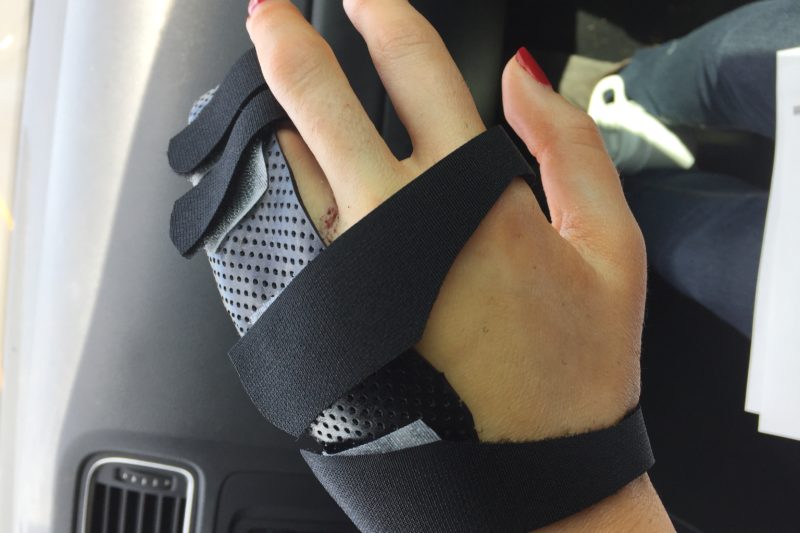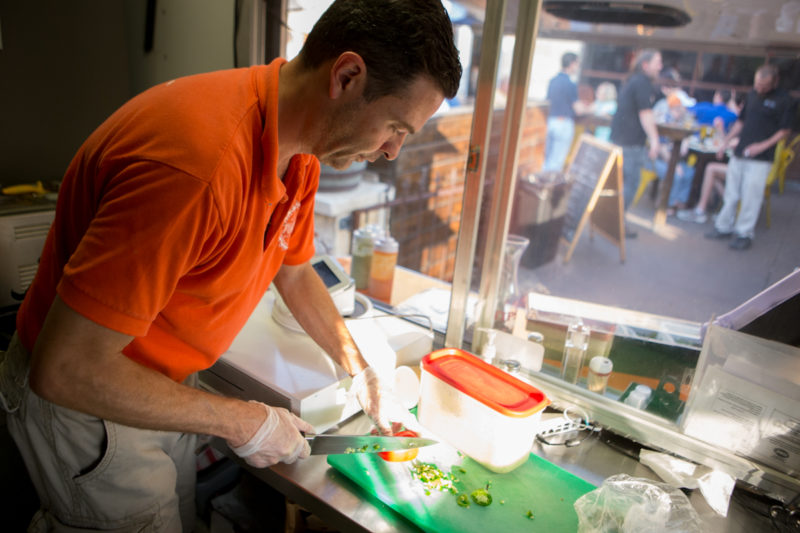Delicious and Dangerous, Avocados Can Be a Slippery Menace
By Taylor Jackson Buchanan
Reporting Texas
The dropped knife clatters jarringly on the marble countertop. I fall to my knees at the kitchen sink, thrust my left hand under the faucet and stare down at the red kitchen rug. My hand is soaked in water, and probably blood. I can’t will myself to look.
My husband Connor wrenches tennis shoes onto my bare feet. He can’t find a pair of socks.
“It’s OK. I don’t need them.” I mumble, and my vision blurs. Dark dots begin to cover his face. “Is it hot in here?”
“You’re in shock,” he says, juggling car keys, a water bottle and a bag of pretzels, foreseeing a long Saturday afternoon ahead. “We’re going to the emergency room.”
Seven hours and six stitches later, my left hand was in a splint and my entire arm in a sling. I had partially severed the extensor tendon on my left ring finger while performing a kitchen maneuver so common I thought it benign. Friends and family were astonished to learn how I hurt myself. Medical professionals in the emergency room were not. I was, in fact, the second person that day to visit the emergency room at the University Medical Center Brackenridge with the same cause of injury.

After surgery to repair the tendon, my ring and pinky fingers were in a brace for 10 days. Physical therapy was prescribed to regain full extension and relearn how to make a fist. Taylor Buchanan/Reporting Texas
I cut my hand open with a butter knife while prying the pit from an avocado.
Alas, the creamy, smooth avocado can be a dangerous fruit, according to chefs, surgeons and physical therapists, a hazard that belies its increasing popularity. Fresh avocado consumption has grown rapidly in the U.S., from 1.5 pounds per person in the 1990s to more than seven pounds in 2016, according to the U.S. Department of Agriculture Economic Research Service.
The fruit’s popularity is rising, especially in southwestern states such as Texas, where more than two out of three households purchase avocados with their groceries. But the obsession sometimes comes with a price. At the center of this favorite fruit lurks a hidden danger. The unassuming avocado actually can be a slippery menace, threatening the preparer’s fingers and palms.
A 2015 survey of 96 emergency rooms found 112 avocado-related injuries serious enough to require emergency care, according to the National Electronic Injury Surveillance System. A similar study conducted a decade earlier reported only 17 such wounds.
The avocado injury list includes actress Meryl Streep, who cut her left hand while slicing an avocado in 2012. She required surgery for the wound.
Sharon Guebert, a hand specialist in Austin, treats avocado-related injuries more often than any other fruit or vegetable wound due to the difficulty involved in removing the large pit. In her 34 years working as an occupational therapist, she has witnessed the aftermath of Halloween horror stories with pumpkin carvings gone awry and dozens of summertime watermelon injuries. But those still don’t outrank the likelihood of injury from an avocado.
“Most people don’t put [the avocado] on a counter or cutting board. They hold it in the palm of their hand. If you miss the pit, the hand is going to get hit somewhere with the knife,” Guebert said.
Often, the injuries are deep and require surgery to repair a severed nerve or tendon. The danger is nestled between the fruit’s soft flesh and the hard, smooth pit on the inside. Most often, a person will stab or pry at the pit with the pointed end of a knife, resulting in a pierced, lacerated or sliced palm, finger or hand. Trying to lever the pit out with a knife point, or planting a knife in the pit and twisting it out, often yields sliced thumbs and fingers. There even have been reports of people slicing directly through an overripe avocado and rotten pit into their palms.
Avocados can strike outside the kitchen, too. Growers and pickers report blunt head trauma, twisted ankles and facial injuries from ladder falls. Avocados are grown commercially in the U.S., Chile, Colombia, Mexico, New Zealand and Israel, and half come from Michoacán, Mexico. Texas has a relatively small presence in commercial avocado production, with the Rio Grande Valley being the primary source.
The fruit’s rise in popularity in the United States is correlated with increased international trade. Avocado shipments from Mexico, the world’s largest producer, were banned until NAFTA legalized their import into the United States in the 1990s. As supply increased, so did demand. Oily, buttery and creamy, the avocado became popular for being fatty in all the right ways. High in monounsaturated, or “good,” fat, the avocado is associated with healthfulness. Texans simply can’t get enough.

Jorge Humphrey, owner and manager of the Top Taco food truck, slices up produce for his customers while stationed outside of Little Woodrow’s Bar on West Parmer Lane. Kara Henderson/Reporting Texas
“Many customers now say, ‘If the taco doesn’t have avocados, I don’t want the taco,’” said Jorge Humphrey, owner and manager of Top Taco, an Austin food truck. “The avocado is part of daily life now.”
Humphrey has worked in the food service industry for more than 20 years. Born and raised in Mexico, he said cooking with avocados is “a way of life” for him. Top Taco adds avocado to a taco for 50 cents and offers a free “avocado spicy sauce” made from scratch daily. Working with the avocado, Humphrey said, injuries “happen to everyone,” and chefs “quickly learn the way not to slice into it.”
“Usually the pit is big,” he said. “I place the knife strongly in the middle of the pit and twist it out, Mexican style. But it’s not easy, and you have to be prepared to use this method or you can really hurt yourself.”
So, what are other avocado enthusiasts to do? Chefs and industry sources such as the Hass Avocado Board recommend a few methods for safer avocado handling. Place the avocado on a firm cutting board or towel on the counter, not in your palm. One option is to cut the fruit in quarters, instead of in half, which allows the pit to pop out more easily. Or stay away from knives and use a spoon or a gadget designed to safely remove avocado pits. The gadgets are relatively inexpensive – especially when compared to a visit to the emergency room, surgery and months of physical therapy – which is how I’ve spent my free time the last 10 weeks.
A bag of lentils, a wiffle ball and athletic tape clutter on my dining room table. Diagrams, scribbled on and well worn, illustrate how to use the props. I’m relearning how to make a fist. I look down at my left hand. It aches, swollen and naked without my wedding ring.
“OMG. Will you ever eat avocados again?” a friend’s text flashes on my phone.
I look over my shoulder toward the kitchen. My husband is making guacamole. I smile and text back, using only my right thumb.